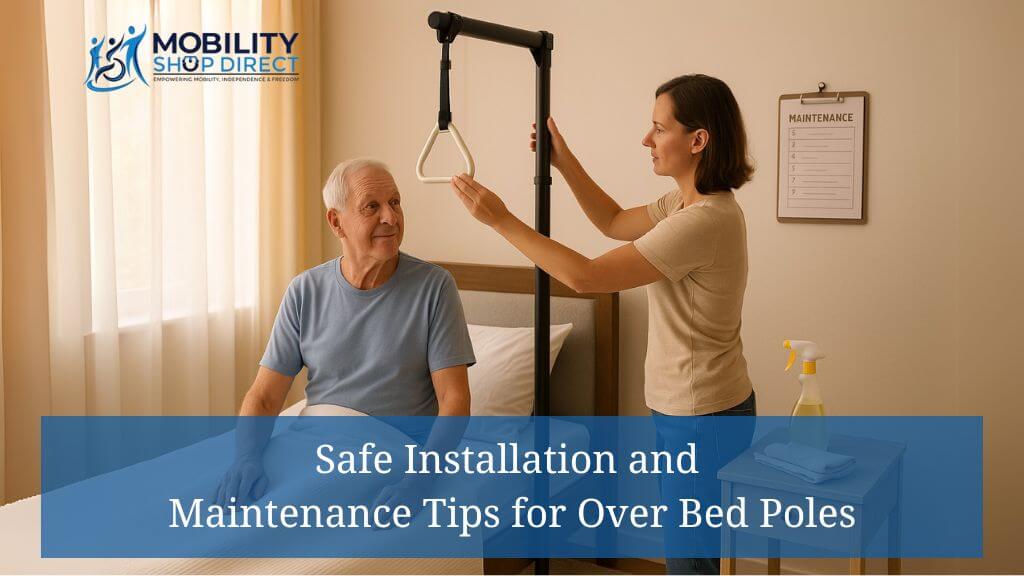Over bed poles are a key mobility aid for many people who need help sitting up or repositioning in bed. But without proper installation and regular checks, they can do more harm than good.
Whether you’re a caregiver or using one yourself, it’s important to understand how to set it up safely, keep it clean, and know when another aid might work better. This guide covers all of that—so you can use an over bed pole confidently and safely.
Table of Contents
- Introduction
- Key Takeaways
- Understanding the Necessity of Safety for Over Bed Poles
- Installation and Setup of Over Bed Poles
- Maintenance and Cleaning of Over Bed Poles
- Situations Where Bed Poles May Not Be Safe
- Exploring Alternatives to Over Bed Poles
- Best Practices for Long-Term Use
- Conclusion
Key Takeaways
For safe and effective use of over bed poles, keep these in mind:
- Install it properly: Always follow the manufacturer's instructions closely.
- Inspect it regularly: Look for wear and tear or loosened parts.
- Know its limits: Make sure the user can safely grip and use the pole.
- Explore other options: If a pole doesn’t suit someone’s needs, things like grab handles or transfer aids may be safer.
- Keep it clean: Regular cleaning helps keep things hygienic and working well.
Understanding the Necessity of Safety for Over Bed Poles
Why Safety is Paramount for Over Bed Poles
Over bed poles support independence and mobility. They’re especially useful for people recovering from surgery, managing chronic conditions, or aging in place. But they can quickly become a hazard if installed or used the wrong way.
If the base isn’t stable, or if someone applies too much pressure, the pole can shift or fall; causing injury. That’s why it’s so important to install it correctly, keep it maintained, and make sure it’s being used as intended.
Installation and Setup of Over Bed Poles
Step-by-Step Guide for Installation
Here’s how to install one safely:
- Start with the manual: Read the instructions from the manufacturer carefully.
- Pick a stable spot: Avoid uneven surfaces and keep it away from bed adjustments.
- Use the right tools: Follow tool recommendations and don’t overtighten screws.
- Check the positioning: It should be easy to reach without creating clutter or hazards.
Risk Assessment Before Installation
Before you set up the pole, think about the user and their environment:
- Can they grip the pole firmly?
- Do they have cognitive or physical limitations that could lead to misuse?
- Could the pole’s placement create tripping risks?
If you’re unsure, it’s worth checking in with a healthcare provider or mobility expert. They can help confirm whether a pole is the best choice.
Maintenance and Cleaning of Over Bed Poles
Routine Safety Inspections
Checking your equipment regularly keeps it safe and working right. Here’s what to do:
- Inspect weekly or monthly: Look for cracks, rust, or loosened bolts.
- Don’t delay repairs: If something’s broken, replace the part—don’t patch it.
For more detailed help, this guide on installation and maintenance tips walks you through common issues.
Cleaning for Hygiene and Functionality
Keeping the pole clean helps avoid health issues and keeps it in good condition.
- Use gentle cleaners: A damp cloth with mild detergent works well.
- Avoid corrosive chemicals: They can wear down the material.
- Stick to a schedule: In shared spaces, clean it more often.
For a full cleaning guide, check out this article on how to clean over bed poles safely.
Situations Where Bed Poles May Not Be Safe
Recognizing Potential Risks
Some situations make over bed poles less safe:
- Unsteady grip or tremors
- Poles that restrict movement or frustrate the user
Determining Unsuitable Conditions for Use
People with advanced arthritis, severe cognitive issues, or very limited mobility might not benefit from a pole. For them, it’s better to consider other aids.
Exploring Alternatives to Over Bed Poles
Practical and Safer Alternatives
If a pole isn’t working out, other aids can help:
- Grab handles and bed rails: Easy to install and good for light assistance.
- Transfer aids: Discs or hoists help with more complex movements.
You can browse a full range of options on our over bed pole collection page.
Factors to Consider When Selecting Alternatives
Before switching, consider:
- How much space is available
- The user's mobility level
- What fits within the budget long term
Best Practices for Long-Term Use
Daily Usage Tips for Safety
Make sure users and caregivers know how to use the pole correctly. Teach proper gripping and encourage reporting any problems right away.
Periodic Evaluations for Continued Suitability
If the user’s condition changes, it might be time to re-evaluate the setup. Swap out the equipment if it no longer meets their needs.
Conclusion
Over bed poles can make life easier, but only when installed and used with care. Set it up the right way, check it regularly, and don’t hesitate to switch to another aid if needed.
If you’re unsure about your setup, start by reviewing it today. A few small changes can make a big difference in safety and peace of mind.



